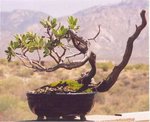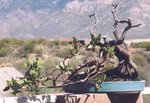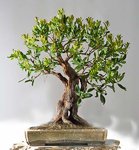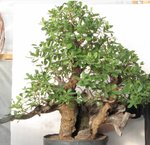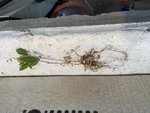Hi folks.
Quick introduction... I used to have a nice small collection of bonsai for many years but lost all of them in the hot summer to a family emergency in 2006.Several species of my large carnivorous plant collection made it but swamp plants in deep tubs of water are more forgiving of neglect than trees in shallow pots.
Now with the virus keeping me mostly at home I have attempt number one in a pot.I know it's said to be nearly impossible by some to pull off collected manzanita but there is a method to my madness.First,it's free in my yard.Second, I've been watching this little bugger since it first showed up at the edge of my driveway a couple years ago and third, it came out with all it's roots,I kept the bad soil it was growing in including the driveway gravel.Third, it's already used to our brutal California summer.
I look forward to very slowly starting a few "normal" bonsai in the coming years enjoying the pictures and tips and learning from all the people on this forum.

Quick introduction... I used to have a nice small collection of bonsai for many years but lost all of them in the hot summer to a family emergency in 2006.Several species of my large carnivorous plant collection made it but swamp plants in deep tubs of water are more forgiving of neglect than trees in shallow pots.
Now with the virus keeping me mostly at home I have attempt number one in a pot.I know it's said to be nearly impossible by some to pull off collected manzanita but there is a method to my madness.First,it's free in my yard.Second, I've been watching this little bugger since it first showed up at the edge of my driveway a couple years ago and third, it came out with all it's roots,I kept the bad soil it was growing in including the driveway gravel.Third, it's already used to our brutal California summer.
I look forward to very slowly starting a few "normal" bonsai in the coming years enjoying the pictures and tips and learning from all the people on this forum.





